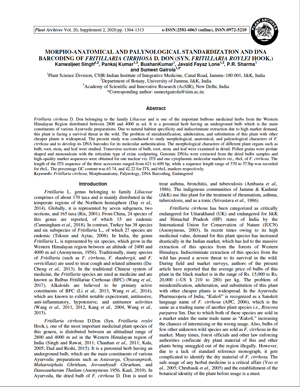NEWS 2020
Morpho-Anatomical and Palynological Standardization and DNA Barcoding of Fritillaria cirrhosa D. Don (Syn. Fritillaria roylei Hook.)
Kanwaljeet SINGH1,2, Pankaj KUMAR1,3, Bushan KUMAR1, Javaid Fayaz LONE1,3, P R SHARMA1, Sumeet GAIROLA1,3
Plant Archives 20, supplement 2: 1304-1313 (2020)
http://www.plantarchives.org/SPL%20ISSUE%2020-2/208__1304-1313_.pdf
1Plant Science Division, CSIR-Indian Institute of Integrative Medicine, Canal Road, Jammu–180 001, J & K, India
2Department of Botany, University of Jammu, J & K, India
3Academy of Scientific and Innovative Research (AcSIR), New Delhi, India
Abstract
Fritillaria cirrhosa D. Don belonging to the family Liliaceae and is one of the important bulbous medicinal herbs from the Western Himalayan Region distributed between 2800 and 4000 m asl. It is a perennial herb having an underground bulb which is the main constituents of various Ayurvedic preparations. Due to natural habitat specificity and indiscriminate extraction due to high market demand, this plant is facing a survival threat in the wild. The problem of misidentification, adulteration, and substitution of this plant with other cheaper plants is widespread. The present study was conducted to study morphological, anatomical, and palynological characters of F. cirrhosa and to develop its DNA barcodes for its molecular authentication. The morphological characters of different plant organs such as bulb, root, stem, and leaf were studied. Transverse sections of bulb, root, stem, and leaf were examined in detail. Pollen grains were prolate shaped and monosulcate with the reticulate type of exine sculpturing. Genomic DNAs were extracted from the dried bulbs samples and high–quality marker sequences were obtained for one nuclear viz. ITS and one cytoplasmic molecular markers viz., rbcL of F. cirrhosa. The length of the ITS sequence of the three accessions ranged from 621 to 699 bp, while a sequence length range of 570 to 573bp was recorded for rbcL. The percentage GC content was 65.74, and 42.22 for ITS, and rbcL markers respectively.




